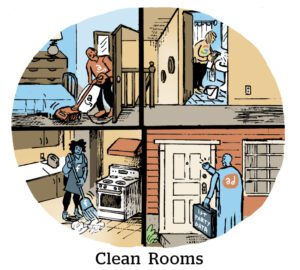TV broadcasters aren’t the only media companies testing data clean rooms for an edge in ad targeting and measurement.
After all, it’s social media platforms that are dealing with the heaviest privacy burdens without scaled third-party cookie data and with Apple’s AppTrackingTransparency (ATT) framework removing most cross-app tracking data.
Earlier this month, Pinterest announced a data clean room solution backed by LiveRamp, with Albertsons onboarding as the first advertiser to pilot the solution.
For Pinterest, a clean room is the logical next step to drive business outcomes for brands without relying on cookies, CRO Bill Watkins told AdExchanger at CES. Watkins has been focused on transforming Pinterest into a shoppable platform since he was promoted to CRO last year.
Other than privacy, Watkins said the point of Pinterest’s clean room pilot is to help boost (and prove) incremental sales for advertisers on the platform.
For CPG companies that lack direct relationships with customers and rely on retailers like Albertsons to attribute sales, a data clean room helps “narrow the path” to product purchases, said Evan Hovorka, head of products and innovation at Albertsons.
Here to shop
The Albertsons Media Collective, as the grocer’s retail media business is called, is no stranger to clean rooms. Retailers are among the very first adopters of the tech, even ahead of TV broadcasters. But clean rooms “don’t necessarily have clean lines to success,” Hovorka said.
Advertisers or publishers (Albertsons is a bit of both, in this case) need to apply clean rooms for specific use cases, not “ambiguous research projects,” to get useful information out of them, Hovorka said.
Albertsons is looking to Pinterest’s clean room to tie offline sales to online behavior, starting with a healthy eating campaign that should drive traffic to fresh produce and healthy snack options.
To set up the clean room campaign, Pinterest and Albertsons each onboard their first-party consumer data to LiveRamp, which hashes and matches Pinterest’s user ID graph with Albertsons’ CRM data. The matches are sent back as anonymized Ramp IDs, which could be segmented into audiences within specific categories or content on Pinterest (such as, say, healthy recipes).
Matching Ramp IDs with the retail transaction data allows Pinterest to attribute campaign performance directly to an advertiser’s KPIs – which is to say, sales and new customers.
“CPGs need closed-loop measurement to justify their media investment,” Watkins said. “Clean rooms are the primary way to do that.”
Still, Watkins added, Pinterest’s clean room pilot is only the first step of a new and iterative process.
“By focusing on ROAS, we can start to learn and understand how to apply the solution to incremental sales, including both net new users and net new sales from already-existing users,” he said.
“The future of our clean room ought to be incrementality,” he added, “which includes building multi-touch attribution into the solution.”
But, for now, Watkins said the first step is “about learning.”
Head in the clouds
Albertsons is also keeping its options open for testing.
The grocer will “eventually move to a position where we’re using cloud-based platforms as part of our clean room solutions,” Hovorka said. That’s a nod to companies like Amazon and Google, which have their clean room products (AWS Clean Rooms and Ads Data Hub, respectively) as part of the cloud business offering, not the ad platform.
But Pinterest isn’t there yet.
“We’re not working in a retailer-owned cloud experience like AWS,” Watkins said. “Our clean room is running in a secure, third-party data hub like LiveRamp.”
Companies are right to be skeptical of relying heavily on software that’s owned by walled gardens, such as AWS or Google Cloud Platform. But a single third-party ID resolution provider won’t be sufficient in the long-term, either.
Albertsons, for example, also works with Habu and InfoSum for clean room measurement solutions, which, Hovorka said, “might be more progressive than LiveRamp in terms of building an end-to-end solution with a user interface that plugs into modern data movement.”
In other words, data – albeit anonymized – needs to be able to move across platforms in order to build up scale.
Pinterest’s clean room, for example, has no bearing on Albertsons’ media spend or campaign performance on other platforms. That lack of interoperability is why clean rooms aren’t solving TV’s measurement mess – and why TV executives say they’re looking to cloud-based “clean tech” as the next step to making fully encrypted data accessible to multiple parties.
Although the tech and use cases still vary, “clean rooms are the next step to digital ad measurement,” Watkins said.
“But this is still early days,” he added, “and it’ll take time for the industry to really bake scale into clean room products themselves.”














